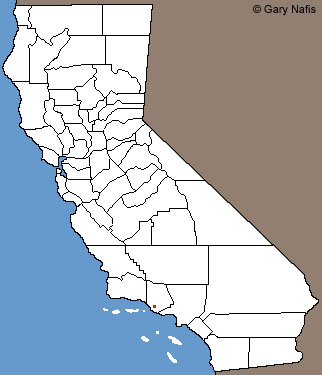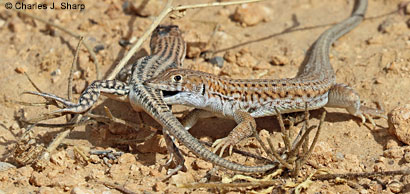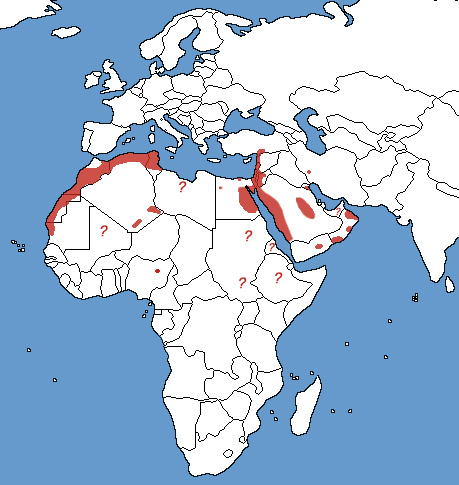 Range in California Range in California: Red
|
This species has been introduced into California. It is not a native species.
|
 |
Dana Biosphere Reserve, Jordan © Charles J. Sharp
(This is a smaller version of the original with a copyright added to it. Click on the image to see the original.) |
 |
Bosc's fringe-toed lizards (Acanthodactylus boskianus asper) love bite as part of courtship, Dana Biosphere Reserve, Jordan © Charles J. Sharp
(This is a smaller version of the original with a copyright added to it. Click on the image to see the original.) |
| |
|
|
You can see pictures of Ventura County lizards on iNaturalist.
(Zoom in on the map to the California observations, click on a marker, then click on an observation, such as this one that shows some of the 18 hatchlings and one adult removed from the wild by people working with the USFWS and USGS.
More pictures of this species can be viewed at the website links below.
|
| |
|
|
|
Description |
(Much of the physical description information below comes from the Hansen and Shedd 2025, because they have been able to observe some of the lizards found in California.)
|
| Size |
Snout to vent length may reach 3.4 inches (87 mm). (Hansen and Shedd 2025)
Average length including tail is 5-8 inches (12.7-20.3 cm).
|
| Appearance |
A medium-sized slender lizard with a pointed snout.
The dorsal surface is an olive gray color with five darker longitudinal stripes. The middle stripe subdivides at the neck.
The throat and underside are white and not marked.
"Dorsal pattern of adults a mix of faint stripes and alternating black and brown blotches; striping is reduced or absent in older adults. Males have yellowish wash on sides of torso and base of tail and have relatively large head and limbs.
Hatchlings are boldly marked, with 7 light stripes on black background; stripes converge near base of tail and fade out by midpoint of tail, which is faint bluish gray on distal half; dorsal surfaces of limbs have vivid light spots on dark background."
(Hansen and Shedd 2025)
The feet have long thin digits with lateral fringes, which are adaptations that help the lizard move quickly across loose sand.
in the breeding season the underside of the tail of a female turns red.
Juveniles have a blue tail.
|
| Life History and Behaviors |
Diurnal
Fast-moving
Forages actively, mostly on the ground, but will jump up to low bushes to catch insects.
Males are territorial, and larger males are typically more successful.
|
| Diet |
| Eats a variety of small invertebrates, including beetles, grasshoppers, spiders, and flies, and small lizards |
| Reproduction and Young |
Oviparous
Females lay 1 or 2 clutches of 2-7 eggs, with an average of four per clutch.
|
| Habitat |
Habitat In California
Lizards in the genus Acanthodactylus not native to California have been established in a small agricultural--industrial area in coastal Ventura County. (Other non-native lizards have also been found in the area, which appears to be a place where people dump unwanted pets.)
"At its single point of introduction in CA, it occupies the interface of an industrial zone, agricultural fields, and a railroad right-of-way, where it occurs with the more abundant Common Side-blotched Lizard (Uta stansburiana.)"
(Hansen and Shedd 2025)
Natural Habitat
Found in arid and semiarid habitats in undisturbed habitats and also in association with human structures.
Dry, sparsely-vegetated areas are favored, but they are not uncommon in other environments.
"It is one of the most common diurnal lizards over much of its range, and is found in a diversity of habitats, including coastal plains and cultivated areas, saltmarshes, oases and wadis, usually in areas with a light to moderate vegetation cover on sandy or gravelly substrates."
(Wickipedia citing Baha el Din, Sherif (2006). A Guide to the Reptiles and Amphibians of Egypt. Oxford University Press)
|
| Range |
Range in California
"A. boskianus was first observed in CA in 2023 near the site of a former reptile-import business, where lizards had escaped or been released."
"Introduced at a single locality along south central coast of CA in Ventura Co., at an elevation of 75 ft (23 m)
."
(Hansen and Shedd 2025)
The lizards were introduced approximately in 2021 or 2022. As of April, 2024, biologists with the U.S. Geological Survey and the U.S. Fish and Wildlife Service are continuing to work on removing them. Since they are limited to a small area there is a good chance they will succeed.
Natural Range
Inhabits North Africa and Western Asia, including Algeria, Chad, Egypt (Nile-delta and parts of the Sinai-Peninsula), Eritrea, Ethiopia, Iran, Iraq, Israel, Jordan, Kuwait, Libya, Mali, Mauritania, Morocco, Niger, Nigeria, Oman, Republic of South Sudan, Saudi Arabia, Sudan, Syria, southern Turkey, Tunisia, the United Arab Emirates, Western Sahara, and Yemen.
|
 |
I can't find any range maps for the species, so the red color here indicates an estimate of the natural range of Acanthodactylus boskianus - Bosc's Fringe-toed Lizard. It is most likely found in more areas than shown here. This map is based largely on iNaturalist observations and other descriptions in the literature. Question marks indicate a country where the species has been listed as occurring, but I don't know where and I did not want to mark the entire country.
(A problem with using the range maps in a user-based resource such as iNaturalist is that it only shows places where people with access to the resource have reported a species, not the full range of a species, which may occur where people do not live or visit. Also, there will be no observations in countries where the resource is not available or not used.)
|
| Taxonomic Notes |
Three subspecies have been described, but they don't appear to be widely accepted. It has not been determined which subspecies the Ventura County lizards belong to, if any.
Acanthodactylus boskianus asper (Audoin 1829)
Acanthodactylus boskianus boskianus (Daudin 1802)
Acanthodactylus boskianus euphraticus Boulenger 1919
"Newly listed species. Native to northern Africa and the Arabian Peninsula. It is established in a small area of coastal Ventura County, California, by October 2023 (Hansen and Shedd. 2025...)"
"An effort is underway to eradicate the species before it spreads further
(Robert N. Fisher, USGS, San Diego, California, personal communication)."
(Nicholson, K. E. (ed.). 2025 SSAR Scientific and Standard English Names List)
|
| Conservation Issues (Conservation Status) |
"Potential ecological impacts on native species are unknown. However, the site's proximity to the Santa Clara River channel presents a corridor for potential dispersal to the east. Observations should be photo-documented and reported to a museum-based herpetologist or the CA Dept. of Fish and Wildlife."
(Hansen and Shedd 2025)
|
|
Taxonomy |
| Family |
Lacertidae |
Wall Lizards, True Lizards, Lacertas |
Oppel, 1811 |
| Genus |
Acanthodactylus |
Fringe-fingered Lizards |
Wiegmann, 1834 |
Species
|
boskianus |
(Daudin, 1802 |
Bosc's Fringe-toed Lizard |
|
Daudin, 1802
|
Meaning of the Scientific Name
|
Acanthodactylus - Greek - "acantho-" - "thorn" or "thorny", and "-dactylus" - "finger" or "digit".
Refers to the characteristic spiny scales on the toes that helps with climbing.
boskianus - Named after French naturalist and botanist Louis Augustin Guillaume Bosc (1759 – 1828).
|
|
Bosc's Fringe-fingered Lizard
|
Related or Similar California Herps
|
Acanthodactylus are very similar in appearance and foraging behavior to native whiptails (and the introduced species also) but the pattern is different and they have small fringes on the hind toes that the whiptails lack.
Only one of the native whiptails is found in Ventura County - the Coastal Whiptail, but the area is not far from the ranges of two others, should A. boskianus increase its range.
Aspidoscelis tigris munda - California Whiptail
Aspidoscelis tigris stejnegeri - Coastal Whiptail
Aspidoscenis tigris tigris - Great Basin Whiptail
Aspidoscelis hyperythra beldingi - Belding's Orange-throated Whiptail
Aspidoscelis sonorae - Sonoran Spotted Whiptail
|
More Information and References
|
Hansen, Robert W. and Shedd, Jackson D. California Amphibians and Reptiles. (Princeton Field Guides.) Princeton University Press, 2025. Pages 148-149.
Baha el Din, Sherif (2006). A Guide to the Reptiles and Amphibians of Egypt. Oxford University Press
Nicholson, K. E. (ed.). 2025 SSAR Scientific and Standard English Names List
iNaturalist
The Reptile Database
Wandering through Wadis - flora and fauna of South Sinai
Wickipedia
|
|
|
The following conservation status listings for this animal are taken from the July 2025 State of California Special Animals List and the July 2025 Federally Listed Endangered and Threatened Animals of California list (unless indicated otherwise below.) Both lists are produced by multiple agencies every year, and sometimes more than once per year, so the conservation status listing information found below might not be from the most recent lists, but they don't change a great deal from year to year.. To make sure you are seeing the most recent listings, go to this California Department of Fish and Wildlife web page where you can search for and download both lists:
https://www.wildlife.ca.gov/Data/CNDDB/Plants-and-Animals.
A detailed explanation of the meaning of the status listing symbols can be found at the beginning of the two lists. For quick reference, I have included them on my Special Status Information page.
If no status is listed here, the animal is not included on either list. This most likely indicates that there are no serious conservation concerns for the animal. To find out more about an animal's status you can also go to the NatureServe and IUCN websites to check their rankings.
Check the current California Department of Fish and Wildlife sport fishing regulations to find out if this animal can be legally pursued and handled or collected with possession of a current fishing license. You can also look at the summary of the sport fishing regulations as they apply only to reptiles and amphibians that has been made for this website.
|
| Organization |
Status Listing |
Notes |
| NatureServe Global Ranking |
|
|
| NatureServe State Ranking |
|
|
| U.S. Endangered Species Act (ESA) |
None |
|
| California Endangered Species Act (CESA) |
None |
|
| California Department of Fish and Wildlife |
None |
|
| Bureau of Land Management |
None |
|
| USDA Forest Service |
None |
|
| IUCN |
|
|
|
|





